How Human Activities Affect Heavy Metal Contamination of Soil and Sediment in a Long-Term Reclaimed Area of the Liaohe River Delta, North China
Abstract
:1. Introduction
2. Materials and Methods
2.1. Study Area
2.2. Sample Collection and Preparation
2.3. Sample Chemical Analysis
2.4. Statistical Analysis
2.5. Index of Geo-Accumulation
3. Results and Discussion
3.1. Descriptive Statistics
3.2. Correlation Analysis of Soil Physicochemical Properties and Metals
3.3. Potential Sources of Heavy Metals in Different Land Use Intensity
3.4. Effects of Land Use Intensity on Soil Properties
3.5. Assessment of Heavy Metal Pollution under Different Land Use Levels
3.6. Implications for Environmental Management and Food Safety
4. Conclusions
Acknowledgments
Author Contributions
Conflicts of Interest
References
- Micó, C.; Recatalá, L.; Peris, M.; Sánchez, J. Assessing heavy metal sources in agricultural soils of an European Mediterranean area by multivariate analysis. Chemosphere 2006, 65, 863–872. [Google Scholar] [CrossRef] [PubMed]
- Sheng, J.J.; Wang, X.P.; Gong, P.; Tian, L.D.; Yao, T.D. Heavy metals of the Tibetan top soils Level, source, spatial distribution, temporal variation and risk assessment. Environ. Sci. Pollut. Res. 2012, 19, 3362–3370. [Google Scholar] [CrossRef] [PubMed]
- Hossain, M.B.; Jahiruddin, M.; Panaullah, G.M.; Loeppert, R.H.; Islam, M.R.; Duxbury, J.M. Spatial variability of arsenic concentration in soils and plants, and its relationship with iron, manganese and phosphorus. Environ. Pollut. 2008, 156, 739–744. [Google Scholar] [CrossRef] [PubMed]
- Wang, W.; Liu, H.; Li, Y.Q.; Su, J.L. Development and management of land reclamation in China. Ocean Coast. Manag. 2014, 102, 415–425. [Google Scholar] [CrossRef]
- Suzuki, T. Economic and geographic backgrounds of land reclamation in Japanese ports. Mar. Pollut. Bull. 2003, 47, 226–229. [Google Scholar] [CrossRef]
- Sheoran, A.S.; Sheoran, V. Heavy metal removal mechanism of acid mine drainage in wetlands: A critical review. Miner. Eng. 2006, 19, 105–116. [Google Scholar] [CrossRef]
- Bai, J.H.; Cui, B.S.; Yang, Z.F.; Xu, X.F.; Ding, Q.Y.; Gao, H.F. Heavy metal contamination of cultivated wetland soils along a typical plateau lake from southwest China. Environ. Earth Sci. 2009, 59, 1781–1788. [Google Scholar] [CrossRef]
- Li, Q.S.; Chen, Y.; Fu, H.B.; Cui, Z.H.; Shi, L.; Wang, L.L.; Liu, Z.F. Health risk of heavy metals in food crops grown on reclaimed tidal flat soil in the Pearl River Estuary, China. J. Hazard. Mater. 2012, 227–228, 148–154. [Google Scholar] [CrossRef] [PubMed]
- Antonijević, M.M.; Dimitrijević, M.D.; Milić, S.M.; Nujkić, M.M. Metal concentrations in the soils and native plants surrounding the old flotation tailings pond of the Copper Mining and Smelting Complex Bor (Serbia). J. Environ. Monit. 2012, 14, 866–877. [Google Scholar] [CrossRef] [PubMed]
- Imperato, M.; Adamo, P.; Naimo, D.; Arienzo, M.; Stanzione, D.; Violante, P. Spatial distribution of heavy metals in urban soils of Naples city (Italy). Environ. Pollut. 2003, 124, 247–256. [Google Scholar] [CrossRef]
- Li, J.G.; Pu, L.J.; Liao, Q.L.; Zhu, M.; Dai, X.Q.; Xu, Y.; Zhang, L.F.; Hua, M.; Jin, Y. How anthropogenic activities affect soil heavy metal concentration on a broad scale: A geochemistry survey in Yangtze River Delta, Eastern China. Environ. Earth Sci. 2015, 73, 1823–1835. [Google Scholar] [CrossRef]
- Ma, C.; Zheng, R.; Zhao, J.L.; Han, X.M.; Wang, L.; Gao, X.J.; Zhang, C.S. Relationships between heavy metal concentrations in soils and reclamation history in the reclaimed coastal area of Chongming Dongtan of the Yangtze River Estuary, China. J. Soils Sediments 2014, 15, 139–152. [Google Scholar] [CrossRef]
- Bai, J.H.; Xiao, R.; Cui, B.S.; Zhang, K.J.; Wang, Q.G.; Liu, X.H.; Gao, H.F.; Huang, L.B. Assessment of heavy metal pollution in wetland soils from the young and old reclaimed regions in the Pearl River Estuary, South China. Environ. Pollut. 2011, 159, 817–824. [Google Scholar] [CrossRef] [PubMed]
- Yang, X.L.; Yuan, X.T.; Zhang, A.G.; Ma, Y.Z.; Li, Q.; Zong, H.M.; Wang, L.J.; Li, X.D. Spatial distribution and sources of heavy metals and petroleum hydrocarbon in the sand flats of Shuangtaizi Estuary, Bohai Sea of China. Mar. Pollut. Bull. 2015, 95, 503–512. [Google Scholar] [CrossRef] [PubMed]
- Li, X.W.; Liang, C.; Shi, J. Developing wetland restoration scenarios and modeling its ecological consequences in the Liaohe River Delta wetlands, China. CLEAN 2012, 40, 1185–1196. [Google Scholar] [CrossRef]
- Di, X.; Hou, X.; Wang, Y.; Li, W. Spatial-temporal characteristics of land use intensity of coastal zone in China during 2000–2010. Chin. Geogr. Sci. 2015, 25, 51–61. [Google Scholar] [CrossRef]
- Li, X.Z.; Sun, Y.G.; Mander, Ü.; He, Y.L. Effects of land use intensity on soil nutrient distribution after reclamation in an estuary landscape. Landsc. Ecol. 2012, 28, 699–707. [Google Scholar] [CrossRef]
- Ellis, S.; Atherton, J.K. Properties and development of soils on reclaimed alluvial sediments of the Humber estuary, eastern England. Catena 2003, 52, 129–147. [Google Scholar] [CrossRef]
- Muller, G. Index of geoaccumulation in sediments of the Rhine River. Geol. J. 1969, 2, 108–118. [Google Scholar]
- Taylor, S.R.; Mclennan, S.M. The geochemical evolution of the continental crust. Rev. Geophys. 1995, 33, 241–265. [Google Scholar] [CrossRef]
- Wu, Y.; Li, J.; Wang, X. Soil Element Background Values of Liaoning Province in China; China Environmental Science Press: Beijing, China, 1994; pp. 1–562. [Google Scholar]
- Wei, J.; Wei, O.Y.; Hao, F.H.; Liu, B.; Wang, F.L. Geochemical variability of heavy metals in soil after land use conversions in northeast China and its environmental applications. Environ. Sci. 2014, 16, 924–931. [Google Scholar]
- Turer, D.; Maynard, J.B.; Sansalone, J.J. Heavy metal contamination in soils of urban highways comparison between runoff and soil concentrations at Cincinnati, Ohio. Water Air Soil Pollut. 2001, 132, 293–314. [Google Scholar] [CrossRef]
- Chapman, P.M.; Wang, F.; Janssen, C.; Persoone, G.; Allen, H.E. Ecotoxicology of metals in aquatic sediments: Binding and release, bioavailability, risk assessment, and remediation. Can. J. Fish. Aquat. Sci. 1998, 55, 2221–2243. [Google Scholar] [CrossRef]
- Zhou, H.Y.; Peng, X.T.; Pan, J.M. Distribution, source and enrichment of some chemical elements in sediments of the Pearl River Estuary, China. Cont. Shelf Res. 2004, 24, 1857–1875. [Google Scholar] [CrossRef]
- Rosenberg, O.; Persson, T.; Högbom, L.; Jacobson, S. Effects of wood-ash application on potential carbon and nitrogen mineralisation at two forest sites with different tree species, climate and N status. For. Ecol. Manag. 2010, 260, 511–518. [Google Scholar] [CrossRef]
- Li, D.; Shao, M.A. Soil organic carbon and influencing factors in different landscapes in an arid region of northwestern China. Catena 2014, 116, 95–104. [Google Scholar] [CrossRef]
- Rainer, B.; Guenther, S.; Luca, M.; Eric, V.R. Carbon concentrations and stocks in forest soils of Europe. For. Ecol. Manag. 2010, 260, 262–277. [Google Scholar]
- Cui, J.; Liu, C.; Li, Z.L.; Wang, L.; Chen, X.F.; Ye, Z.Z.; Fang, C.M. Long-term changes in topsoil chemical properties under centuries of cultivation after reclamation of coastal wetlands in the Yangtze Estuary, China. Soil Tillage Res. 2012, 123, 50–60. [Google Scholar] [CrossRef]
- Zhang, H.; Wang, Z.F.; Zhang, Y.L.; Hu, Z.J. The effects of the Qinghai—Tibet railway on heavy metals enrichment in soils. Sci. Total Environ. 2012, 439C, 240–248. [Google Scholar] [CrossRef] [PubMed]
- Laing, G.D.; Rinklebe, J.; Vandecasteele, B.; Meers, E.; Tack, F.M.G. Trace metal behaviour in estuarine and riverine floodplain soils and sediments: A review. Sci. Total Environ. 2008, 407, 3972–3985. [Google Scholar] [CrossRef] [PubMed]
- Zhang, W.; Yu, L.; Hutchinson, S.M.; Xu, S.; Chen, Z.; Gao, X. China’s Yangtze Estuary: I. Geomorphic influence on heavy metal accumulation in intertidal sediments. Geomorphology 2001, 41, 195–205. [Google Scholar] [CrossRef]
- Shi, J.B.; Ip, C.C.; Zhang, G.; Jiang, G.B.; Li, X.D. Mercury profiles in sediments of the Pearl River Estuary and the surrounding coastal area of South China. Environ. Pollut. 2010, 158, 1974–1979. [Google Scholar] [CrossRef] [PubMed]
- Duan, D.D.; Ran, Y.; Cheng, H.F.; Chen, J.A.; Wan, G.J. Contamination trends of trace metals and coupling with algal productivity in sediment cores in Pearl River Delta, South China. Chemosphere 2014, 103, 35–43. [Google Scholar] [CrossRef] [PubMed]
- Osuji, L.C.; Onojake, C.M. Trace heavy metals associated with crude oil: A case study of ebocha-8 oil-spill-polluted site in Niger Delta, Nigeria. Chem. Biodivers. 2004, 1, 1708–1715. [Google Scholar] [CrossRef] [PubMed]
- Santos-Echeandía, J.; Prego, R.; Cobelo-García, A. Influence of the heavy fuel spill from the Prestige tanker wreckage in the overlying seawater column levels of copper, nickel and vanadium (NE Atlantic ocean). J. Mar. Syst. 2008, 72, 350–357. [Google Scholar] [CrossRef]
- Nie, M.; Xian, N.; Fu, X.; Chen, X.; Li, B. The interactive effects of petroleum-hydrocarbon spillage and plant rhizosphere on concentrations and distribution of heavy metals in sediments in the Yellow River Delta, China. J. Hazard. Mater. 2010, 174, 156–161. [Google Scholar] [CrossRef] [PubMed]
- Sutherland, T.F.; Petersen, S.A.; Levings, C.D.; Martin, A.J. Distinguishing between natural and aquaculture-derived sediment concentrations of heavy metals in the Broughton Archipelago, British Columbia. Mar. Pollut. Bull. 2007, 54, 1451–1460. [Google Scholar] [CrossRef] [PubMed]
- Min, W.F.; Liu, C.Z.; Xue, S.Y.; Ling, G.Y.; Xian, Y.J. Investigation on the pollution of organoarsenical additives to animal feed in the surroundings and farmland near hog farms. Acta Ecol. Sin. 2006, 26, 154–162. [Google Scholar]
- Fakayode, S.O.; Olu-Owolabi, B.I. Heavy metal contamination of roadside topsoil in Osogbo, Nigeria: Its relationship to traffic density and proximity to highways. Environ. Geol. 2003, 44, 150–157. [Google Scholar]
- Yan, Y.C.; Xin, X.P.; Xu, X.L.; Wang, X.; Yang, G.X.; Yan, R.R.; Chen, B.R. Quantitative effects of wind erosion on the soil texture and soil nutrients under different vegetation coverage in a semiarid steppe of northern China. Plant Soil 2013, 369, 585–598. [Google Scholar] [CrossRef]
- Wei, J.; Wei, O.Y.; Hao, F.; Wang, F.; Liu, B. Long-term cultivation impact on the heavy metal behavior in a reclaimed wetland, Northeast China. J. Soils Sediments 2013, 14, 567–576. [Google Scholar]
- Six, J.; Conant, R.T.; Paul, E.A.; Paustian, K. Stabilization mechanisms of soil organic matter: Implications for C-saturation of soils. Plant Soil 2002, 241, 155–176. [Google Scholar] [CrossRef]
- Shen, J.B.; Yuan, L.X.; Zhang, J.L.; Li, H.G.; Bai, Z.H.; Chen, X.P.; Zhang, W.F.; Zhang, F.S. Phosphorus dynamics: From soil to plant. Plant Physiol. 2011, 156, 997–1005. [Google Scholar] [CrossRef] [PubMed]
- Boesch, D.F. Challenges and opportunities for science in reducing nutrient over-enrichment of coastal ecosystems. Estuaries 2002, 25, 886–900. [Google Scholar] [CrossRef]
- Caeiro, S.; Costa, M.H.; Ramos, T.B.; Fernandes, F.; Silveira, N.; Coimbra, A.; Medeiros, G.; Painho, M. Assessing heavy metal contamination in Sado Estuary sediment: An index analysis approach. Ecol. Indic. 2005, 5, 151–169. [Google Scholar] [CrossRef]
- Banat, K.M.; Howari, F.M.; Al-Hamad, A.A. Heavy metals in urban soils of central Jordan: Should we worry about their environmental risks? Environ. Res. 2005, 97, 258–273. [Google Scholar] [CrossRef] [PubMed]
- Yaylalı-Abanuz, G. Heavy metal contamination of surface soil around Gebze industrial area, Turkey. Microchem. J. 2011, 99, 82–92. [Google Scholar] [CrossRef]
- Feng, M.H. Ecological risk evaluation of heavy metals of marine sediment in Liaodong Bays shallow waters. Mar. Sci. 2003, 27, 52–56. [Google Scholar]
- Li, Q.S.; Liu, Y.N.; Du, Y.F.; Cui, Z.H.; Shi, L.; Wang, L.L.; Li, H.J. The behavior of heavy metals in tidal flat sediments during fresh water leaching. Chemosphere 2011, 82, 834–838. [Google Scholar] [CrossRef] [PubMed]
- Cheng, S. Heavy metal pollution in China: Origin, pattern and control. Environ. Sci. Pollut. Res. 2003, 10, 192–198. [Google Scholar] [CrossRef]
- Sowana, A.; Shrestha, R.P.; Parkpian, P.; Pongquan, S. Influence of coastal land use on soil heavy-metal contamination in Pattani Bay, Thailand. J. Coast. Res. 2013, 27, 252–262. [Google Scholar] [CrossRef]
- Frimmel, F.H.; Huber, L. Influence of humic substances on the aquatic adsorption of heavy metals on defined mineral phases. Environ. Int. 1996, 22, 507–517. [Google Scholar] [CrossRef]
- Basta, N.; Raun, W.; Gavi, F. Wheat grain cadmium under long-term fertilization and continuous winter wheat production. Better Crops 1998, 82, 14–15. [Google Scholar]
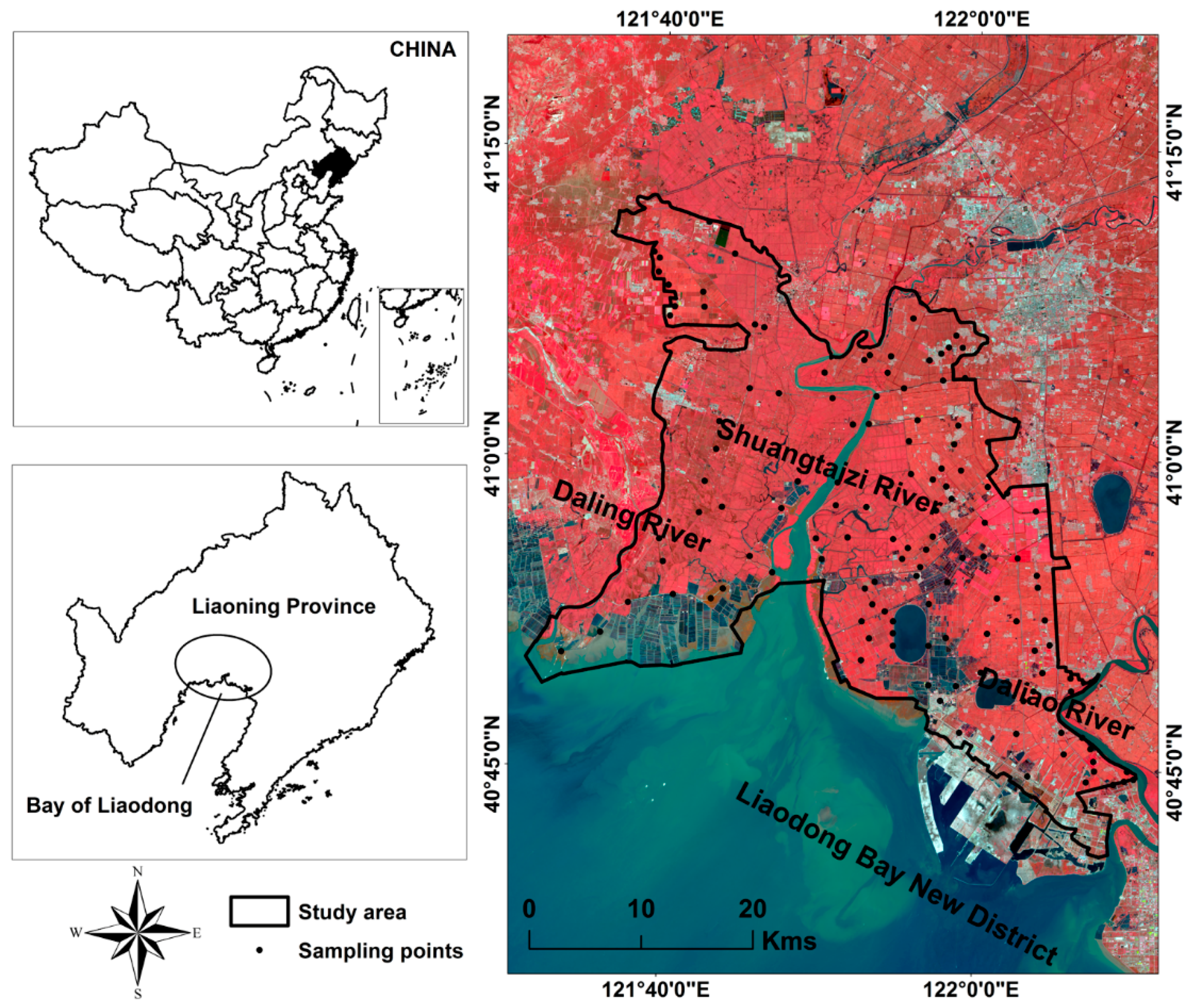
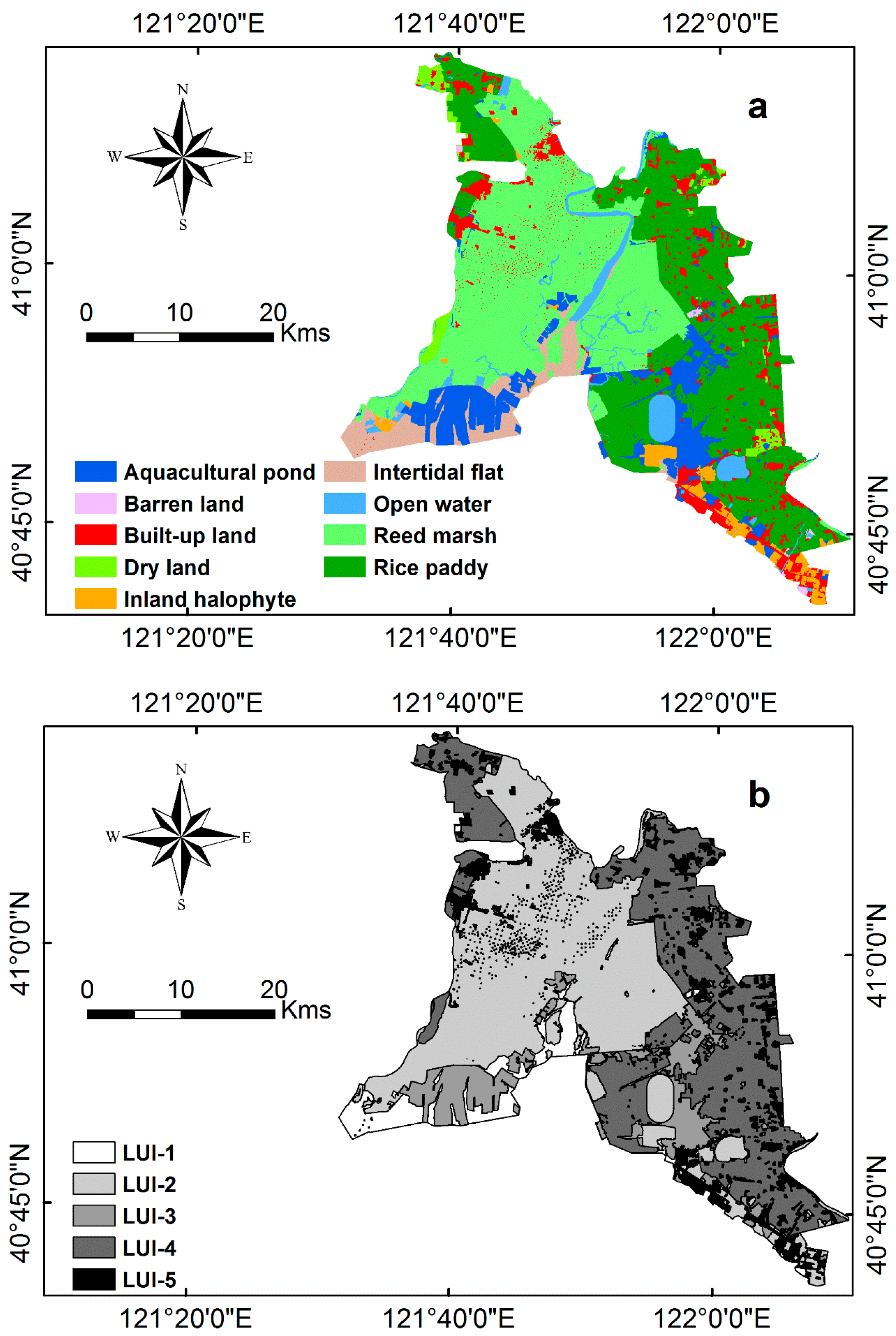

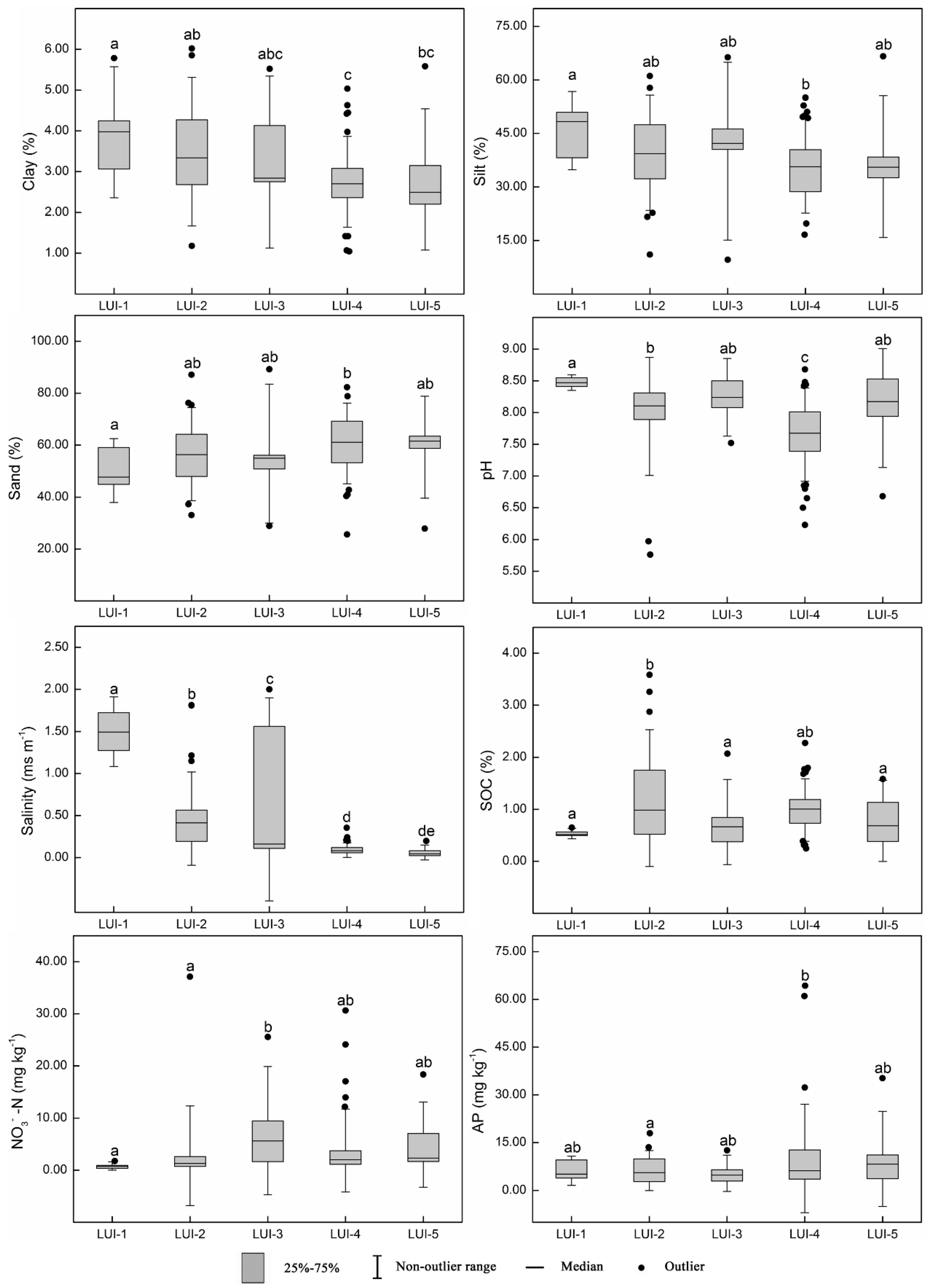
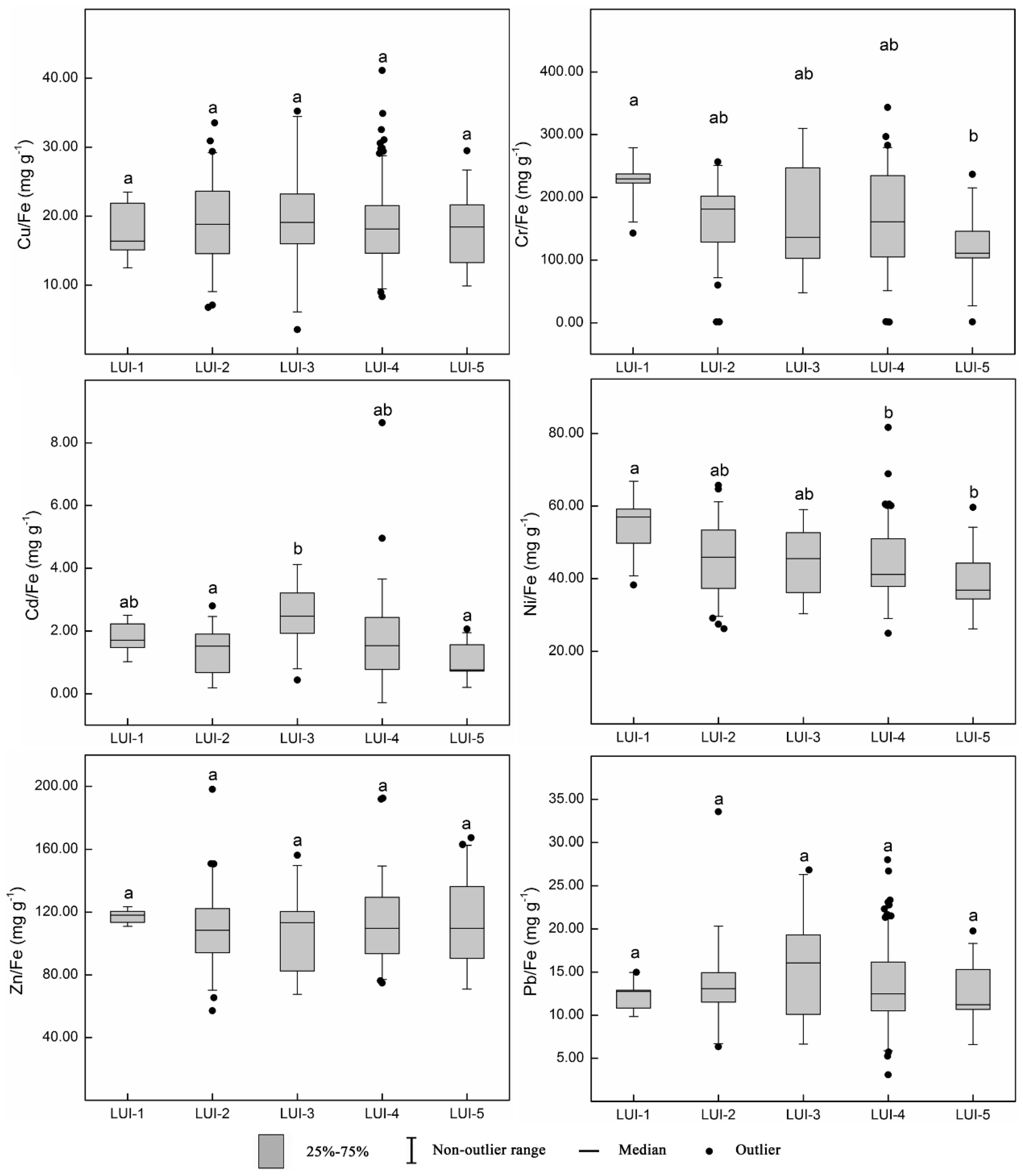
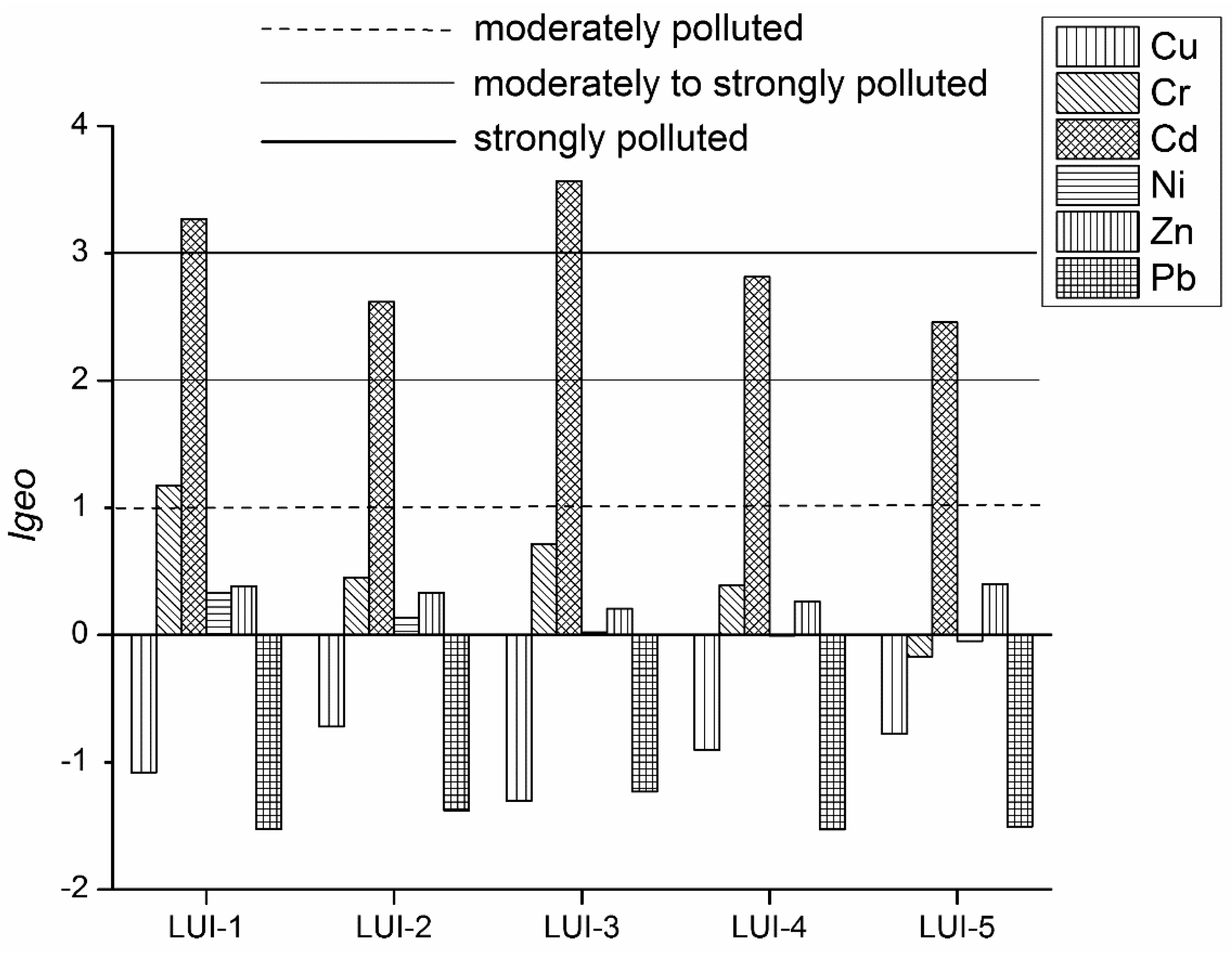
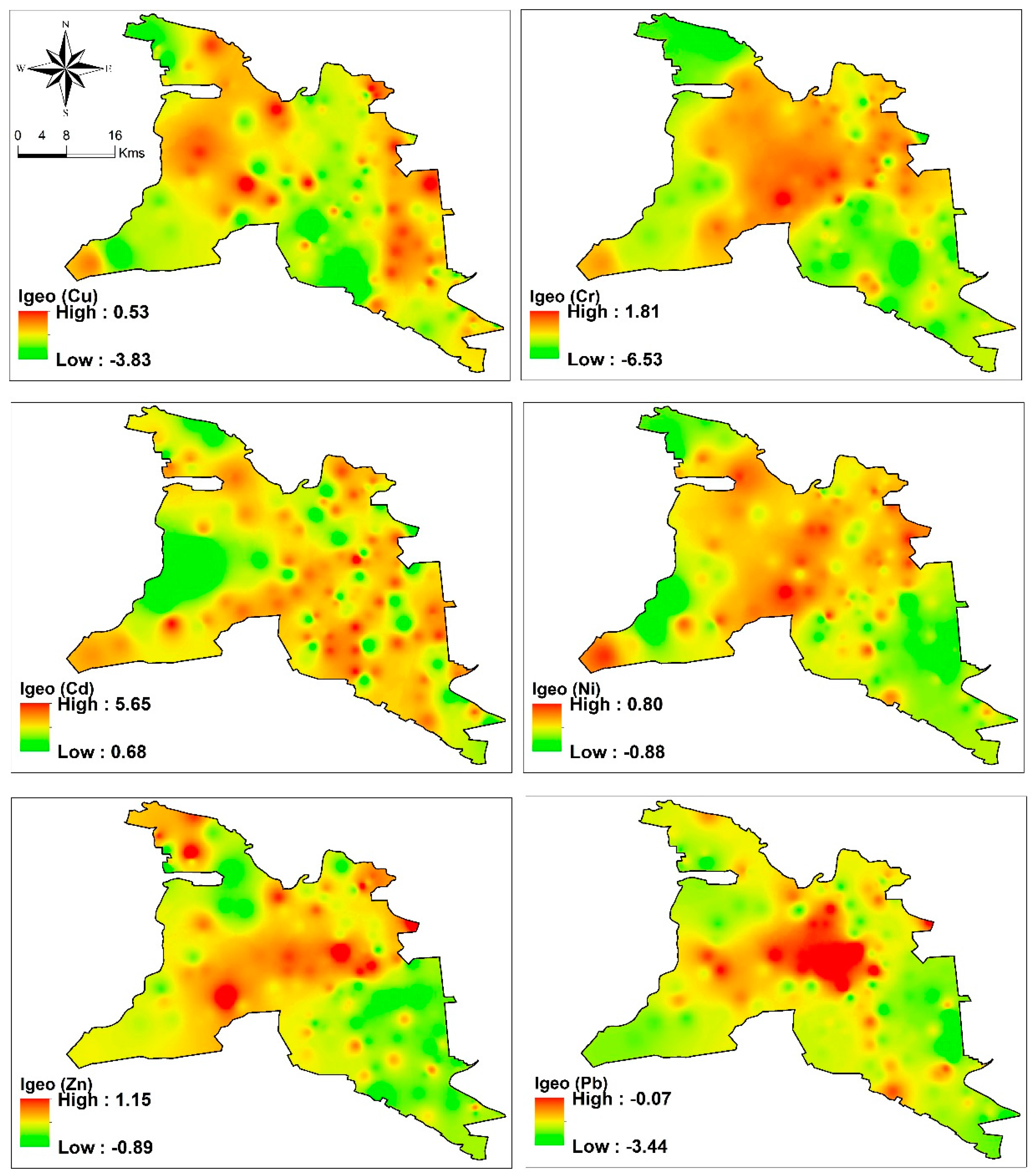
| Land Use Intensities (LUI) | Land Use Type | Area Percent (%) | Descriptions |
|---|---|---|---|
| LUI-1 | Barren land | 0.2 | Saline land formed early on reclamation areas; Unutilized land for industry construction |
| Intertidal flat | 5.0 | Intertidal mud flat areas with less than 30% vegetation cover | |
| LUI-2 | Reed marsh | 35.6 | Estuarine and reclamation areas with vegetation cover exceeding 30%, dominated by reeds |
| Open water | 4.5 | Rivers, artificial reservoirs and ponds | |
| Inland halophyte | 2.5 | Reclamation areas with vegetation cover exceeding 30%, dominated by Suaeda | |
| LUI-3 | Aquacultural pond | 9.9 | Artificial ponds for fish/shrimp/crab farming |
| LUI-4 | Rice paddy | 32.7 | Paddy fields or aquatic agricultural crop cultivated land |
| Dry land | 2.0 | Xeric agricultural crop cultivated land | |
| LUI-5 | Built-up land | 7.6 | Residential, industrial and transportation lands |
| Variable | Minimum | Median | Maximum | Mean | S.D. | C.V. (%) |
|---|---|---|---|---|---|---|
| Cu (mg kg−1) | 4.55 | 15.65 | 31.67 | 17.23 | 6.05 | 35.10 |
| Cr (mg kg−1) | 50.65 | 153.43 | 275.79 | 154.95 | 52.16 | 33.66 |
| Cd (mg kg−1) | 0.26 | 1.63 | 3.46 | 1.41 | 0.82 | 58.23 |
| Ni (mg kg−1) | 20.87 | 39.33 | 59.34 | 40.71 | 9.13 | 22.44 |
| Zn (mg kg−1) | 53.40 | 99.59 | 149.50 | 102.21 | 19.44 | 19.02 |
| Pb (mg kg−1) | 2.95 | 11.26 | 19.57 | 11.97 | 3.66 | 30.54 |
| Mn (mg kg−1) | 25.78 | 96.42 | 211.90 | 100.46 | 30.94 | 30.80 |
| Fe (g kg−1) | 0.63 | 0.93 | 1.18 | 0.93 | 0.12 | 12.63 |
| Salinity (ms m−1) | 0.01 | 0.11 | 0.62 | 0.15 | 0.14 | 97.33 |
| pH | 6.65 | 7.95 | 8.80 | 7.89 | 0.48 | 6.07 |
| SOC (%) | 0.05 | 0.84 | 2.88 | 0.93 | 0.48 | 51.81 |
| NO3−-N (mg kg−1) | 0.25 | 1.56 | 10.72 | 2.35 | 2.23 | 94.68 |
| AP (mg kg−1) | 0.72 | 5.61 | 26.46 | 7.23 | 5.41 | 74.80 |
| Clay (%) | 1.04 | 2.83 | 6.02 | 3.04 | 1.04 | 34.09 |
| Silt (%) | 9.59 | 37.19 | 66.58 | 37.63 | 10.46 | 27.81 |
| Sand (%) | 25.60 | 59.07 | 89.25 | 58.72 | 11.63 | 19.81 |
| Cu | Cr | Cd | Ni | Zn | Pb | Mn | Fe | Salinity | pH | SOC | NO3−-N | AP | Clay | Silt | Sand | |
|---|---|---|---|---|---|---|---|---|---|---|---|---|---|---|---|---|
| Cu | 1 | |||||||||||||||
| Cr | 0.47 ** | 1 | ||||||||||||||
| Cd | 0.22 ** | 0.20 ** | 1 | |||||||||||||
| Ni | 0.52 ** | 0.71 ** | 0.30 ** | 1 | ||||||||||||
| Zn | 0.71 ** | 0.52 ** | 0.19 ** | 0.57 ** | 1 | |||||||||||
| Pb | 0.43 ** | 0.25 ** | 0.23 ** | 0.35 ** | 0.37 ** | 1 | ||||||||||
| Mn | 0.29 ** | −0.11 | 0.05 | −0.10 | 0.16 | 0.13 | 1 | |||||||||
| Fe | 0.57 ** | 0.35 ** | 0.24 ** | 0.27 ** | 0.28 ** | 0.20 ** | 0.39 ** | 1 | ||||||||
| Salinity | 0.03 | 0.25 ** | 0.07 | 0.20 * | −0.02 | 0.07 | 0.01 | −0.03 | 1 | |||||||
| pH | −0.14 * | −0.09 | −0.13 | −0.17 | −0.04 | −0.33 ** | 0.24 ** | 0.18 ** | 0.38 ** | 1 | ||||||
| SOC | 0.32 ** | 0.24 ** | 0.34 ** | 0.26 ** | 0.25 ** | 0.13 | 0.02 | 0.07 | −0.30 | −0.32 ** | 1 | |||||
| NO3−-N | 0.01 | −0.07 | −0.06 | −0.07 | −0.08 | 0.18 | 0.09 | −0.05 | −0.26 ** | −0.22 * | 0.33 ** | 1 | ||||
| AP | −0.10 | −0.01 | 0.12 | −0.06 | −0.05 | 0.16 | −0.03 | −0.01 | −0.09 | −0.10 | 0.05 | 0.15 | 1 | |||
| Clay | 0.29 ** | 0.37 ** | 0.13 ** | 0.29 ** | 0.23 ** | 0.13 | 0.20 * | 0.16 | 0.27 ** | 0.18 | 0.37 ** | −0.21 * | −0.22 * | 1 | ||
| Silt | 0.35 ** | 0.43 ** | 0.23 ** | 0.35 ** | 0.32 ** | 0.05 | 0.17 | 0.06 | 0.13 | 0.05 | 0.23 ** | 0.04 | −0.22 * | 0.78 ** | 1 | |
| Sand | −0.37 ** | −0.44 ** | −0.15 ** | −0.36 ** | −0.27 ** | −0.06 | −0.17 | −0.12 | −0.07 | 0.01 | −0.26 ** | 0.03 | 0.28 ** | −0.82 ** | −0.99 ** | 1 |
| LUI-1 | LUI-2 | LUI-3 | LUI-4 | LUI-5 | ||||||
|---|---|---|---|---|---|---|---|---|---|---|
| 1 | 2 | 1 | 2 | 1 | 2 | 1 | 2 | 1 | 2 | |
| Cu/Fe | 0.97 | 0.02 | 0.76 | 0.19 | 0.43 | 0.83 | 0.67 | 0.25 | 0.21 | 0.85 |
| Cr/Fe | 0.54 | 0.67 | 0.15 | 0.87 | 0.95 | 0.06 | 0.79 | 0.43 | 0.89 | 0.09 |
| Cd/Fe | 0.15 | 0.92 | 0.84 | 0.07 | 0.07 | 0.98 | 0.04 | 0.83 | 0.47 | 0.36 |
| Ni/Fe | 0.44 | 0.84 | 0.56 | 0.64 | 0.91 | 0.38 | 0.86 | 0.15 | 0.97 | 0.05 |
| Zn/Fe | 0.93 | 0.29 | 0.82 | 0.29 | 0.35 | 0.79 | 0.82 | 0.35 | 0.85 | 0.04 |
| Pb/Fe | 0.53 | 0.64 | 0.04 | 0.64 | 0.98 | 0.18 | 0.30 | 0.74 | 0.39 | 0.71 |
| Eigenvalue | 2.69 | 2.49 | 2.41 | 1.69 | 3.51 | 1.97 | 2.57 | 1.62 | 2.89 | 1.38 |
| Total variance (%) | 44.92 | 41.61 | 40.16 | 28.28 | 58.43 | 32.82 | 42.77 | 27.07 | 48.20 | 22.94 |
| Cumulative variance (%) | 44.92 | 86.53 | 40.16 | 68.44 | 58.43 | 91.25 | 42.77 | 69.84 | 48.20 | 71.14 |
© 2018 by the authors. Licensee MDPI, Basel, Switzerland. This article is an open access article distributed under the terms and conditions of the Creative Commons Attribution (CC BY) license (http://creativecommons.org/licenses/by/4.0/).
Share and Cite
Yan, X.; Liu, M.; Zhong, J.; Guo, J.; Wu, W. How Human Activities Affect Heavy Metal Contamination of Soil and Sediment in a Long-Term Reclaimed Area of the Liaohe River Delta, North China. Sustainability 2018, 10, 338. https://doi.org/10.3390/su10020338
Yan X, Liu M, Zhong J, Guo J, Wu W. How Human Activities Affect Heavy Metal Contamination of Soil and Sediment in a Long-Term Reclaimed Area of the Liaohe River Delta, North China. Sustainability. 2018; 10(2):338. https://doi.org/10.3390/su10020338
Chicago/Turabian StyleYan, Xiaolu, Miao Liu, Jingqiu Zhong, Jinting Guo, and Wen Wu. 2018. "How Human Activities Affect Heavy Metal Contamination of Soil and Sediment in a Long-Term Reclaimed Area of the Liaohe River Delta, North China" Sustainability 10, no. 2: 338. https://doi.org/10.3390/su10020338





